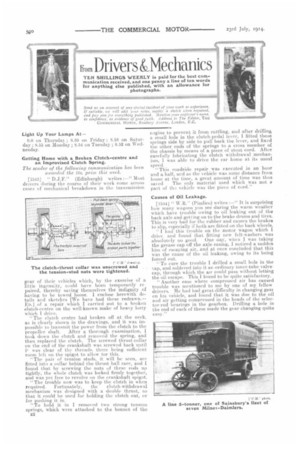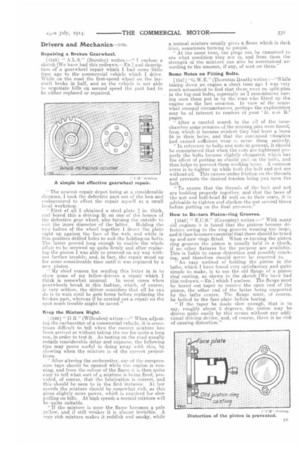Eom Drivers & Mechanics
Page 24

Page 25

If you've noticed an error in this article please click here to report it so we can fix it.
TEN SHILLINGS WEEKLY is paid for the best communication received, and one penny a line of ten words for anything else published, with an allowance for photographs.
Send us an account of any shecial incident of your work or experience, If suitable, we will edit your notes, supply a sketch when required, and pay you for everything published. Mention your employer's name, in confidence, as evidence of good faith. Address to The Editor, THE COMMERCIAL morcaz, Rosthery Avenue, London, E.G.
Light Up Your Lamps At 9.0 on Thursday ; 8.59 on Friday ; 8.58 on Saturday; 8.53 on Monday ; 8.54 on Tuesday ; 8.52 on Wednesday.
Getting Home with a Broken Clutch-.centre and an Improvised Clutch Spring.
The sender of the following communication hcts been awarded the 10s. prize this week.
[1543J " D.J.F." (Edinburgh) writes :—" Most drivers during the course of their work come across cases ef mechanical breakdown in the transmission
gear of their vehicles which, by the exercise of a little ingenuity, could have been temporarily repaired, thereby saving themselves the indignity of having to be towed home. 1 enclose herewith details and sketches [We have had these redrawn.-En.] of a repair which I carried out to a broken-clutch-centre on the well-known make of heavy lorry which I drive.
" The clutch centre had broken off at the neck, as is clearly shown in the drawings, and it was impossible to transmit the power from the clutch to the propeller shaft. After a thorough examination, I took down the clutch and removed the spring, and then replaced the clutch. The screwed thrust-collar on the end of the crankshaft was screwed back until was clear of the threads. there being sufficient room left on the spigot to allow for this.
"The pair of tension studs, it will be seen, are fitted into a collar behind the thrust ball race, and 1 found that by screwing the nuts of these rods up tightly, the whole clutch was locked firmly together, and was yet. free to revolve on the crankshaft spigot. "The trouble now was to keep the clutch in when required. Fortunately, the clutch-withdrawal mechanism was designed with a double thrust, so that it could be used for holding the clutch out, or for pushing it. in.
"To hold it in I removed two strong tension springs, which were attached to the bonnet of the E9,
engine to prevent it from rattling, and after drilling a small hole in the clutch-pedal lever, I fitted these springs side by side to pull back the lever, and fixed the other ends of the springs to a cross member of the chassis by means of a piece of stout cord. After carefully lubricating the clutch withdrawal mechanism, I was able to drive the car home at its usual speed,
" This roadside repair was executed in an hour and a half, and as the vehicle was some distance from home at the time, a great amount of time was thus
saved The only material used which was not a part of tho vehicle was the piece of cord."
Causes of Oil Leakage.
[15,14] " W.R." (Pimlico) writes :—" It is surprising how many wagons you see during the warm weather which have trouble owing to oil leaking out of Um back axle and getting on to the brake drums and tires. This is very bad for the rubber and causes the brakes to slip, especially if both are fitted on the back wheels.
"I had this trouble on the motor wagon which I drive, and found that fitting new felt-washers was absolutely no good. One oay, when I was taking the grease cap off the axle casing, I noticed a sudden hiss of escaping air, and at once concluded that this was the cause of the oil leaking, owing to its being forced out.
"To cure the trouble I drilled a small hole in the cap, and soldered into it an ordinary inner-tube valve• cap, through which the air could pass without letting the oil escape. This I lound to be quite satisfactory.
" Another case where compressed air has caused trouble was mentioned to me by one of my fellow drivers. He had hail gyeatdifficulty in changing gent on his vehicle, and found that it was due to the oil and air getting compressed in the heads of the selector-rod bearings in the gearbox. Drilling a hole in the end of each of these made the gear changing quite easy." Repairing a Broken Gearwheel.
[1545] " (Burnley) writes :—" I enclose a sketch [We have had this redrawn.—En.] and description of a gearwheel repair which I had some little time ago to the commercial vehicle which I drive. While on the road the first.-speed wheel on the layshaft broke in half, and as the vehicle is not able to negotiate hills on second speed the part had to be either replaced or repaired.
" The nearest repair depot being at a considerable distance, I took the defective part out of the box and endeavoured to effect the repair myself at a small local workshop.
" First af all I obtained a steel plate in. thick, and bored this a driving fit on one of the bosses of the defective gear wheel, also turning the outside to suit the inner diameter of the latter. Holding the two halves of the wheel together I drove the plate sight up against the face of the web, arid while in this position drilled holes to suit the holding-on bolts. The latter proved long enough to enable the whole affair to be screwed up quite firmly and after replacing the pinion I was able to proceed on my way without. further trouble, and, in fact, the repair stood up for sonic considerable time until it was replaced by a new pinion.
"My chief reason for sending this letter in is to show sonic of my fellow-drivers a repair which I think is somewhat unusual. In most eases when gearwheels break in this fashion, which, of course, is very seldom, the driver considers that all he can. do is to wait until he gets home before replacing the broken part, whereas if he carried out a repair on the spot much trouble might be saved."
Keep the Mixture Right.
[1546] " D.B." (Willesden) writes :—" When adjusting the carburetter of a commercial vehicle, it is sometimes difficult to tell when the correct mixture has been arrived at without taking the ear for quite a long run, in order to test it. As testing on the road usually entails considerable delay and expense, the following tips may prove useful in doing away with this, by showing when the mixture is of the correct propor. tines.
"After altering the carburetter, one of the compression taps should he opened while the engine is running, and from the colour of the flame it is then quite easy to tell what sort of a mixture is being fired, provided, of course, that the lubrication is correct, and this should be seen to in the first instance. At low speeds the mixture should be somewhat rich, as this gives slightly more power, which is required for slow pulling on hills. At high speeds a normal mixture will be quite suitable.
"If the mixture is poor the flame becomes a pale yellow, and if still weaker it is almost invisible. A very rich mixture makes it reddish and smoky, while a normal mixture usually gives a flame which is dark .blue, sometimes turning to purple.
" At the same time, the plugs can be examined to see what condition they ate in, and from them the strength of the mixture can also be ascertained according to the amount, if any, of soot on them."
Some Notes on Fitting Bolts.
[1547f "G.W.E." (Thornton Reath) writes :—"While taxing down an engine a short time ago I was very much astonished to find that there were no split-pins in the big-end bolts, especially as I remembesed having seen them put in by the mean who fitted up the engine on the last occasion. In view af the somewhat unusnal circumstances, perhaps the explanation may be of interest to readers of your
pages.
" After a easeful search in the eil of the basechamber some remains of the missing pins were found, from which it became evident they had been a loose fit in their holes, and that the continued vibration had caused sufficient wear to sever them entirely.
" In reference to bolts and nuts in general, it should be remembered that when the nuts are tightened properly the bolts become slightly elongated, which has the effect of putting an elastic pull on the bolts, and thus helps to prevent them working loose. A common error is to tighten up while both the bolt and nut are without oil. This causes undue friction on the threads and prevents the desired tension being put upon the bolt o ensure that the threads of the bolt and nut are bedding properly together, and that the faces of the nut and bolt-head fit well on to their seats, it is advisable to tighten and slacken the nut several times before putting on the final pressure."
How to Re-turn Piston-ring Grooves.
[1548] " E.C.S." (Coventry) writes :—" With many old engines it is found that the pistons become defective owing to the ring grooves wearing too large, and it then becomes essential that these should be trued up and new rings fitted. When re-turning the piston ring grooves the piston is usually held in a chuck, if no other fixtures for the purpose are available. This is liable to cause distortion and possibly cracking, and therefore should never be resorted to. "An easy method of holding the piston in the lathe, which I have found very satisfactory and quite simple to make, is to use the old flange of a piston ring casting, as shewn in the sketch [We have had this redrawn.—En] which I enclose. The flange must be bored out taper to receive the open end of the piston, the other end of the latter being supported by the lathe centre. The flange must, of course. be bolted to the face-plate before boring.
"If the taper be made slow enough, that is to say, roughly about 3 degrees, the piston may be driven quite easily by this meanswithout any additional driving .device, and, of course, there is no risk of causing distortion."


























